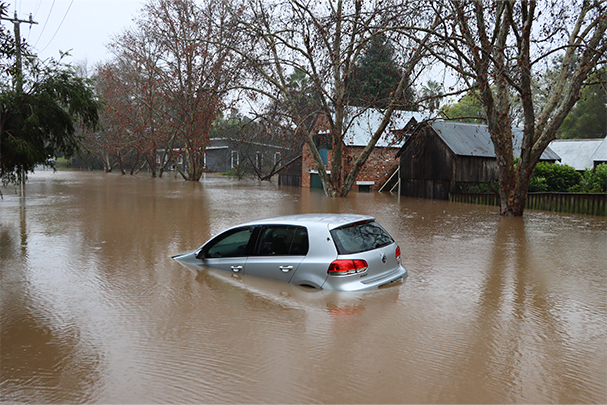
Nationwide Vehicle Contracts explain the Dos and Don'ts when driving through flood water
Driving on flooded roads is never a good idea. Avoiding it whenever possible is the safest option. If you're driving and you come across floodwater on the road, if it's safe to do so, turn around and go another route.
However, we know that isn't always possible. So, to help keep you safe, Nationwide Vehicle Contracts has put together a blog explaining the best safety tips for staying safe while driving through water or unexpectedly encountering flooding on the road.
What causes flooding?
With the phrase 'flood water', you start to imagine swamped roads and washed-away trees, but it's not always that dramatic.
Intense rainfall, burst river banks, severe storms, blocked drains, the loss of nearby wetlands, and building on flood plains, alongside other factors, are all contributors to the formation of flood water. There may not necessarily be an extreme weather event for you to encounter a flooding hazard.
Tips for driving through heavy rain flood water
Wipers and tyres
Your windscreen wipers should be functioning correctly and able to clean the glass without leaving streaks or squeaking annoyingly. New wipers are always a good idea in the months leading up to autumn.
Also, check your tyres' condition and tread depth since your tyres are the only thing linking your braking and steering inputs to the road. Tyres must have 1.6mm of tread depth to be considered legal. However, it is generally advised to replace them when they reach 3mm, or roughly the thickness of a 20p coin's border. Finally, inspect the rubber for rips, tears, and any signs of perishing.
Slow down
Keep your speed down and leave more space between your car and the vehicles in front of you because stopping distances will be at least twice as long in the rain as in good weather.
Take it slow in case you aquaplane
When water gets between the surface of the road and your tyre, it causes aquaplaning, which essentially robs you of grip and control. Taking it slow and not making any rash steering inputs should help restore order.
Additionally, if it's raining and visibility is poor, ensure your headlights are on. If you break down, don't leave your bonnet open since water could enter the electrical system.
Driving through flowing flood water
Find an alternative route if the water on the road is flowing quickly. Fast-moving water doesn't need to be very deep to wash away an automobile, and floodwaters can cause fatalities.
Driving through standing flood water
Do not drive through water if you have any doubts about its depth. Get out first, measure the depth with a stick, mentally remember where the water reaches on the stick, and then compare this to your automobile. You might need to get your feet or pants wet to achieve this. However, be careful since even slowly moving water can knock you off your feet, and floodwater can hide sharp or dangerous obstacles and trip hazards.
Your best bet is to avoid driving through water if it is higher than the lowest point on the car's bodywork, which is typically the front bumper's bottom or the sills under the doors.
It's also important to note that if any water gets sucked into your engine, the engine will bend and shatter rather than the water because water cannot be squeezed. Even a small amount of water can damage a vehicle's electronics.
Also, keep in mind that if the water is too murky or deep for you to see the road through, you won't be able to tell if any drain covers or manholes have floated, adding to the danger.
Avoiding driving through flooded roads whenever possible is the safest option, but if you feel comfortable with the circumstances and want to drive through flood water, keep the following in mind:
1. Drive one at a time
It's best to take it in turns and let cars go ahead of you as if a leading vehicle gets stuck or breaks down, it could force you to reverse back out of the flood, which is difficult at the best of times and even more difficult if there are other drivers behind you.
Apply the same reasoning to drivers going the other way, as they could produce a bow wave causing the water to be deeper at points and increasing the possibility of your vehicle being swept away.
2. Drive in the middle of the road
Use the fact that roads are taller in the centre than at the sides to your advantage. Driving in the middle will lessen your probability of going onto a soft verge or colliding with a curb.
3. Reduce your speed, but not too much
Water can be powerful and dangerous if you drive too quickly, it could pull your car's bumper or other parts off, cause your tyres to slide off the road, or force water into the engine compartment, under wheel-arch liners, or anywhere else.
However, you should maintain some momentum since this will produce a tiny bow wave that will keep the water level lower than it might be. Using your own judgement is always ideal, but 3 to 4 mph should be about right. In a manual transmission vehicle, be ready to drop the clutch to maintain the revs and don't let the car come to a complete stop.
4. Keep your revs high
Keep the engine in first gear to maintain a fast speed and if driving an automatic transmission vehicle, lock into a low gear if the gearbox permits. Keeping the revs high will help keep water from entering the exhaust while reducing the risk of the car stalling.
5. Test and dry your brakes once going through water
Once you're out of the floodwater, use your brakes to remove any moisture and ensure they function properly before using them.
Find out more about Car Leasing by calling Nationwide Vehicle Contracts on 0345 811 9595 to speak to one of our experienced leasing consultants about the right option for you.

